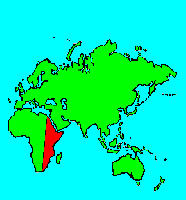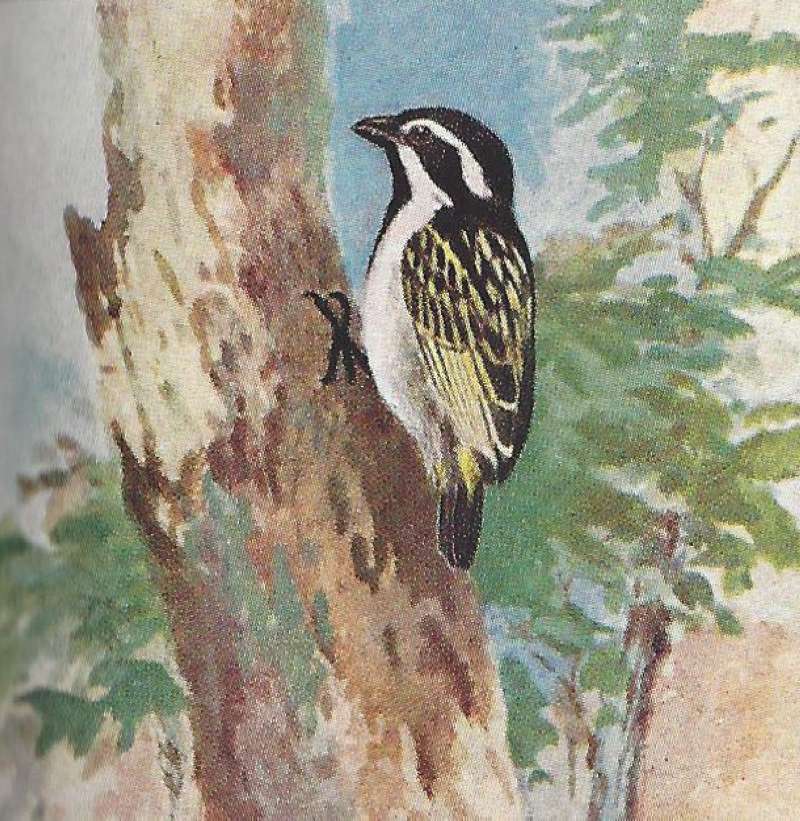SPECIES INFO
Black throated barbet (Tricholaema melanocephala) is found in eastern Africa. This is found from Ethiopia and Eritrea south to northern Tanzania. This barbet has a black head marked with a white stripe over the eye and a second white stripe from the bill base to the white breast. The center throat is black.
There are four subspecies. The nominate subspecies, Tricholaema melanocephala melanocephala, is found in northern Africa from Eritrea west into central Ethiopia and northwestern Somalia. The subspecies blandi is found in northern Somalia. The subspecies stigmatothorax is found from southern Ethiopia and southern Somalia to north eastern Tanzania. The subspecies flavibuccalis is found in northern Tanzania.The barbet genus Tricholaema is found widely in Africa, but most of the species are limited to eastern and southern Africa. There are 6 species. Although some show lots of white, the widespread and western most species, T. hirsuta is dark green with a dark face. The tails are generally small.
The African barbet family (Lybiidae) is found in Africa, and appears almost absent from Madagascar. There are about 42 species in this group.
Some modern authors place this subfamily as part of the toucan (Ramphasatidae) family.
The Collins Field Guide for the Birds of East Africa uses the family name of Capitonidae for this group. (First printed in 1980 and reprinted numerous times.)
The Howard and Moore Checklist of 2003 uses the name Lybiinae for the African group of barbets. The Sibley-Monroe Distribution and Taxonomy places this group as the family Lyiidae in the superfamily Lybioidea.
Woodpeckers and Toucans (Order Piciformes) are separated from most other birds by an unusual tendon and foot arrangement that includes two forward and two rear pointing toes. There are six families in this order. Most species in this order have unusual bills adapted for their unique way of obtaining food.
Some taxonomists place the puffbirds and jacamars in various places in the taxonomy tree. We have included the puffbirds (Bucconidae) and jacamars (Galbulidae) herein.
Aves contains about 8,650 different species of living birds known to science. Each year about one new species is discovered in some remote rain forest or remote island. In addition, scientists have been raising many subspecies to full species status which may raise the species count to 10,000. Birdlife recognizes 10,027 species as of 2011.
However, each year about one species goes extinct. The rate of extinction is increasing, and the rate of new discovery is decreasing, so that the number of bird species will soon begin to decline rapidly. Although different taxonomists would organize the birds differently, there are approximately twenty-seven orders of birds. These orders are broken down into about one hundred and fifty-five different families.
Recent research of the genetic structure of some of the shore birds and owls would indicate that the present organization of orders and families should have some modification.
The birds are a worldwide group of animals that are characterized by having the front limbs modified into wings that are used for flying. Perhaps the most unique feature of the birds is the feathers. These feathers are made up of a central support called a quill and a series of small filaments that are hooked together as barbs.
For many years it was believed that Archaeopteryx discovered in Bavaria was the oldest bird from about 150 million years ago. However, in l986, Sankar Chattterjee, a Texas paleontologist, reportedly discovered a bird in the genus Protoavis that lived about 225 million years ago.
When this project was begun in 1978, we used Austin & Singer for bird taxonomy. Since then, we have adopted many changes, but have kept some older concepts that are still found widely in the literature. Recently, we have used Clements and Howard & Moore. Very recently, we have used Monroe and Sibley for the higher taxonomy of the perching birds.
Backboned Animals (Phylum Chordata) are the most advanced group of animals on earth. These animals are characterized by having a spinal cord or backbone. Most members have a clearly defined brain that controls the organism through a spinal cord. Fish, amphibians, reptiles, birds, and mammals are in this phylum.
Currently, some taxonomists believe that the fish should be divided into two groups (sharks and regular fishes) and that there are some other primitive groups in the phylum such as hagfish or lampreys.
Animal Kingdom contains numerous organisms that feed on other animals or plants. Included in the animal kingdom are the lower marine invertebrates such as sponges and corals, the jointed legged animals such as insects and spiders, and the backboned animals such as fish, amphibians, reptiles, birds, and mammals.


